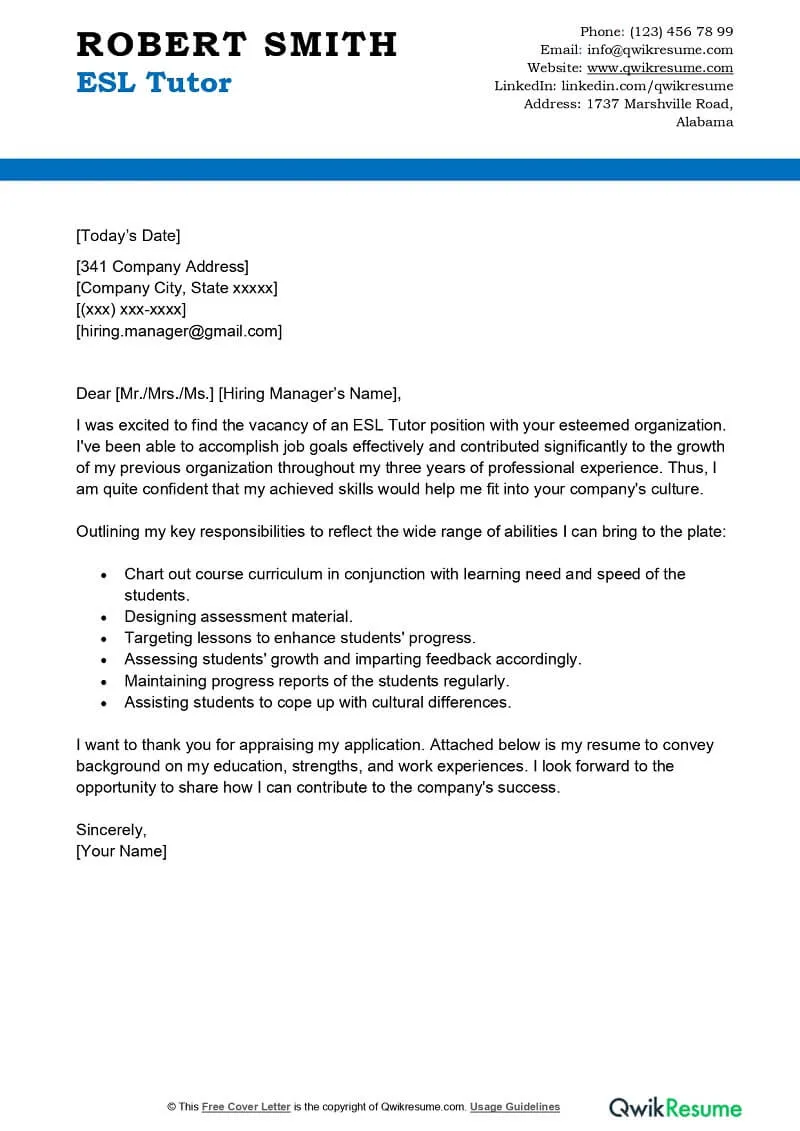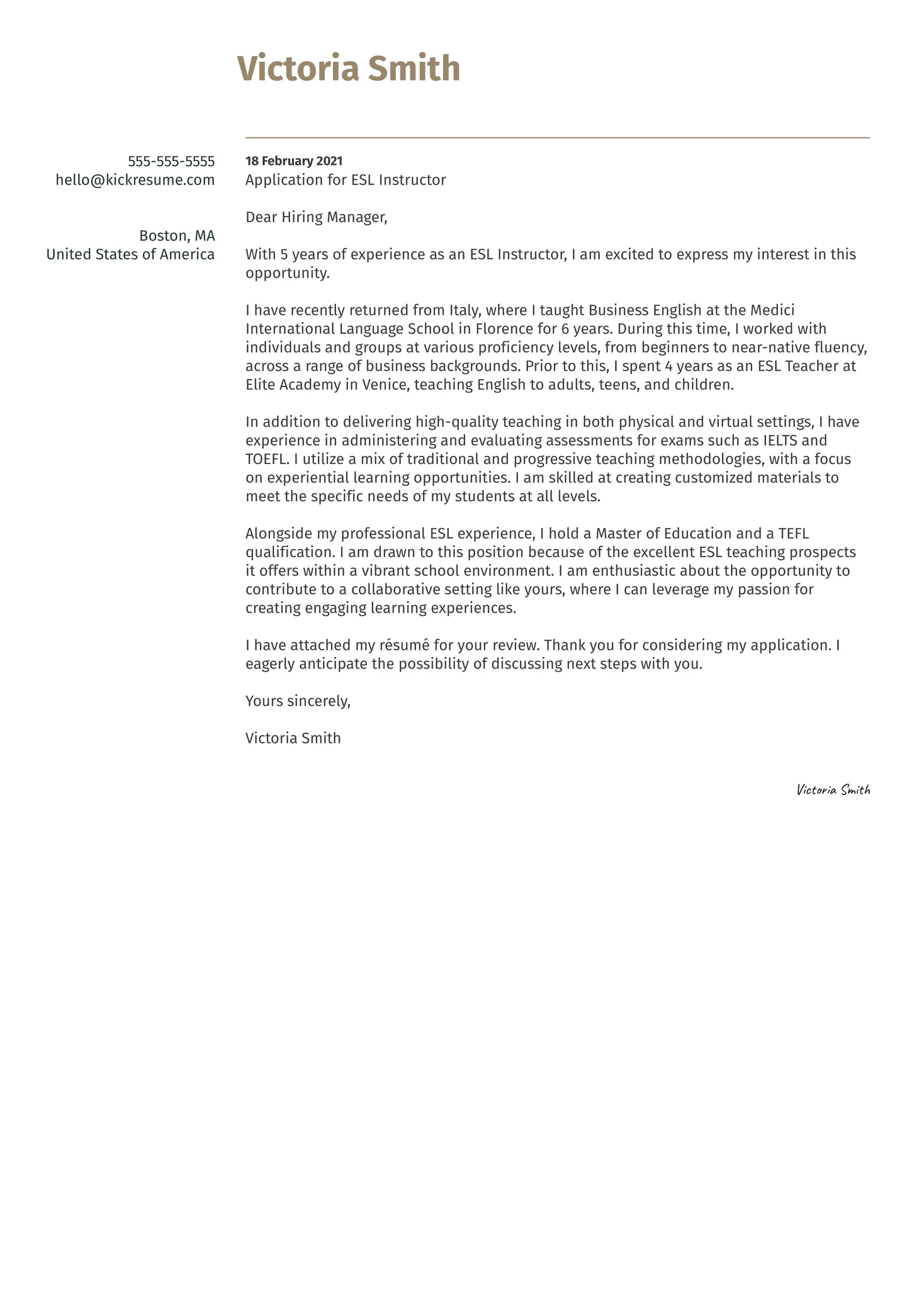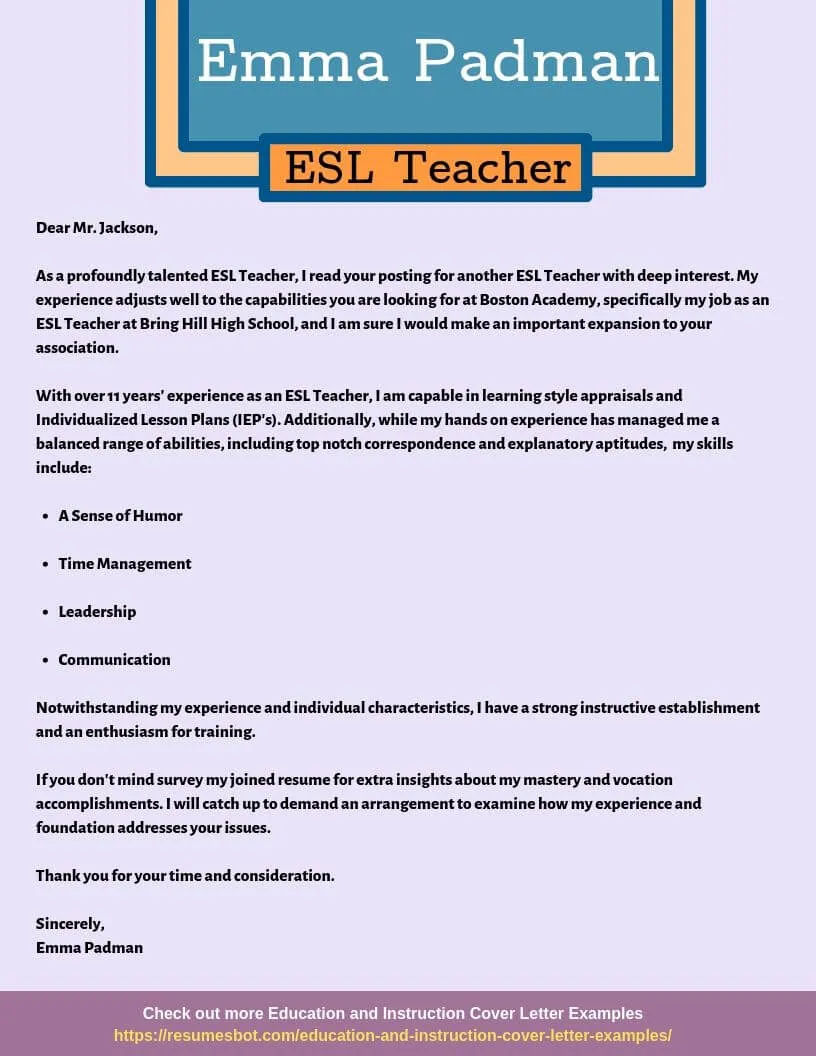ESL Cover Letter Essentials
A well-crafted ESL cover letter is your key to unlocking exciting teaching opportunities. It’s your first impression, a snapshot of your qualifications, experience, and passion for teaching English as a Second Language. This guide delves into the essential components of a compelling cover letter, providing practical advice and actionable strategies to help you stand out from the competition and land your dream job. Writing a strong cover letter can sometimes be a daunting task, but with the right approach, you can showcase your unique skills and make a lasting impact on potential employers. Remember, the goal is to create a document that reflects your personality, expertise, and dedication to ESL teaching.
Understanding the Purpose of an ESL Cover Letter
The primary purpose of an ESL cover letter is to introduce yourself to a potential employer and express your interest in a specific ESL teaching position. It goes beyond simply listing your qualifications; it’s an opportunity to connect with the hiring manager on a personal level and demonstrate why you’re the perfect fit for the role. It should complement your resume by providing context, elaborating on your skills, and highlighting your enthusiasm for ESL teaching. Think of it as your chance to tell a story, painting a vivid picture of your capabilities and aspirations, and making the reader want to know more about you. The cover letter also offers a great space to discuss your understanding of their specific needs and how you can address them.
Highlighting Your Qualifications and Experience

Your cover letter is the perfect platform to showcase your qualifications and experience in the field of ESL. Be specific about your accomplishments and quantify them whenever possible. Instead of simply stating that you have experience teaching, mention the number of years you’ve taught, the age groups you’ve worked with, and the specific skills you’ve honed. Do you have certifications such as TEFL, TESOL, or CELTA? Clearly state them and provide the issuing institution. Also, highlight any specialized training, such as experience with specific teaching methodologies (e.g., communicative language teaching) or experience with specific student populations (e.g., young learners, adults). Remember to tailor your experience to match the requirements outlined in the job description.
Tailoring Your Cover Letter to the Specific Job
A generic cover letter is easily identified and often discarded. To make your application stand out, personalize your cover letter for each job you apply for. Carefully read the job description and identify the key requirements and desired qualifications. Then, in your cover letter, explicitly address how your skills and experience align with those needs. Use keywords from the job description throughout your letter. If the job emphasizes classroom management skills, provide examples of how you’ve successfully managed classrooms in the past. If the position requires experience with a specific curriculum, mention your familiarity with it or your willingness to learn it. This demonstrates that you have taken the time to understand the role and are genuinely interested in the opportunity.
Crafting the Perfect ESL Cover Letter Structure
A well-structured cover letter is easy to read and helps the reader quickly grasp your key qualifications. The standard format includes an introduction, body paragraphs, and a conclusion. Each section serves a specific purpose, guiding the reader through your qualifications and making a compelling case for why you are a strong candidate. Keeping your cover letter concise and focused is also important; aim for a single page, using clear language and avoiding unnecessary jargon. A well-formatted letter makes it easier for the hiring manager to find the information they need to assess your suitability for the position, increasing your chances of getting an interview.
The Introduction Paragraph

The introduction is your chance to make a strong first impression. Start by stating the specific position you’re applying for and how you found the job listing. Briefly introduce yourself, highlighting your most relevant qualifications and expressing your enthusiasm for the opportunity. If you were referred by someone, mention their name. Aim to capture the reader’s attention with a brief statement that demonstrates your knowledge of the school or program and your passion for ESL teaching. Avoid generic openings; instead, make it clear why you are the ideal candidate, creating intrigue and encouraging them to read further. The goal is to make the reader want to learn more about you.
The Body Paragraphs
The body paragraphs are where you elaborate on your qualifications, skills, and experience. Focus on providing specific examples that demonstrate your abilities. Use the STAR method (Situation, Task, Action, Result) to describe your accomplishments. For example, instead of saying “I improved student test scores,” you could write, “In my previous role, I implemented a new vocabulary-building strategy that resulted in a 15% increase in student test scores.” This provides concrete evidence of your effectiveness. Tailor the content to the specific requirements outlined in the job description. The body of your cover letter should be well-organized, logical, and easy to follow, showcasing your expertise and passion for ESL teaching in a clear and concise manner.
The Conclusion Paragraph
The conclusion is your final opportunity to reinforce your interest in the position and encourage the hiring manager to contact you. Reiterate your enthusiasm for the role and summarize your key qualifications. Express your eagerness to discuss your application further and thank the reader for their time and consideration. Include a call to action, such as stating that you are available for an interview at their earliest convenience. Provide your contact information again, making it easy for the employer to reach you. Ensure that your tone is confident but not arrogant, leaving a positive and lasting impression.
Essential Elements to Include in Your ESL Cover Letter

Several key elements should always be included in your ESL cover letter to make it complete and compelling. These elements demonstrate your understanding of ESL teaching and your suitability for the role. Failing to include these components could weaken your application and decrease your chances of being selected for an interview. Carefully consider each element and tailor it to the specific job requirements, ensuring that your letter is comprehensive and informative.
Your Teaching Philosophy
Your teaching philosophy is a statement of your beliefs about teaching and learning. Briefly describe your approach to ESL instruction, including your preferred teaching methodologies and your views on student engagement and classroom management. Highlight what inspires you to teach and what goals you have for your students. Do you prioritize a communicative approach, focusing on real-world language use? Do you emphasize creating a supportive and inclusive classroom environment? Do you have experience using technology to enhance language learning? Include a brief summary of your teaching style. Make sure that your teaching philosophy reflects your personality and demonstrates your dedication to your students’ success.
Your Relevant Skills and Experience
Clearly articulate the skills and experience that make you a strong candidate for the position. Focus on the most relevant qualifications, such as your experience teaching specific age groups or proficiency in particular language skills (reading, writing, speaking, and listening). Do you have experience with lesson planning, curriculum development, or assessment? Mention those skills. Provide examples of how you’ve used your skills to achieve positive outcomes for your students. Quantify your accomplishments whenever possible. Show rather than just tell by providing concrete examples of how you’ve successfully implemented your skills in a classroom setting. The more detail you provide, the more persuasive your cover letter will be.
References and Contact Information

Always include your contact information, including your phone number and email address, so the employer can easily reach you. In some cases, the job posting might request references. If so, be sure to provide the names, titles, and contact information of your references. It’s advisable to inform your references that they may be contacted. If references are not explicitly requested, you can include a statement like, “References available upon request.” This demonstrates your readiness to provide further information about your skills and experience. Make sure your email address is professional, and double-check that your contact information is accurate.
Common Mistakes to Avoid in Your ESL Cover Letter
Avoiding common mistakes can significantly improve your cover letter and increase your chances of getting an interview. These errors can damage your credibility and make a negative impression on the hiring manager. Before submitting your cover letter, carefully review it for the following pitfalls.
Typos and Grammatical Errors
Typos and grammatical errors are the most common and easily avoidable mistakes. They make your cover letter look unprofessional and can suggest a lack of attention to detail. Always proofread your cover letter carefully, or better yet, have a friend or colleague review it. Use spell-check and grammar-check tools, but remember that these tools are not foolproof. Ensure that the language is clear, concise, and free of errors. Even a single mistake can undermine your credibility. A polished cover letter demonstrates your professionalism and your commitment to excellence.
Generic and Uninspired Content

A generic cover letter that could be sent to any employer is unlikely to impress the hiring manager. Tailor your cover letter to the specific job requirements and the school or program you’re applying to. Avoid using vague phrases and clichés. Instead, provide specific examples that showcase your unique skills and experience. Show your enthusiasm for the particular opportunity. Generic letters fail to show that you understand the role and are genuinely interested in the position. Your cover letter should clearly reflect your personality and passion for ESL teaching. Show the employer why you are a great fit, and this will help you stand out from other applicants.
Ignoring the Job Description
Failing to address the requirements outlined in the job description is a significant mistake. Read the job description carefully and identify the key qualifications, skills, and experience the employer is seeking. Then, in your cover letter, explicitly address how your skills and experience align with those needs. Use keywords from the job description. If the job description emphasizes experience with a specific teaching methodology, provide examples of your experience. Demonstrate that you have taken the time to understand the role and are capable of fulfilling its responsibilities. Ignoring the job description shows a lack of attention to detail and demonstrates that you have not bothered to personalize your application.
Proofreading and Editing Your ESL Cover Letter
Proofreading and editing are crucial steps in ensuring your cover letter is polished and professional. Before submitting your application, take the time to carefully review your cover letter for any errors. Read it aloud to catch awkward phrasing or grammatical mistakes. Consider using a proofreading tool, but also have a friend or colleague review it. Ask them for feedback on clarity, conciseness, and overall impact. A well-edited cover letter demonstrates your professionalism and attention to detail, increasing your chances of a positive impression. Ensure the final version is free of errors and conveys your enthusiasm for the position.
By following these guidelines, you can create a compelling ESL cover letter that showcases your skills, experience, and passion for teaching, increasing your chances of landing your dream job. Good luck with your job search!
